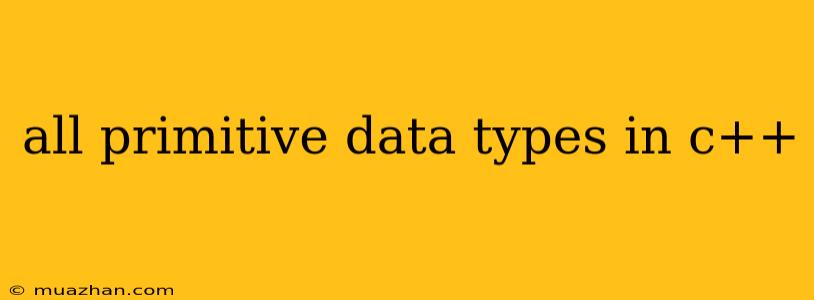All Primitive Data Types in C++
C++ provides several fundamental data types, known as primitive data types, which are built into the language and serve as the foundation for storing different kinds of data. These data types are essential for creating variables and performing calculations.
Here's a comprehensive look at all the primitive data types in C++:
1. Integer Data Types
Integers are whole numbers without any fractional part. C++ offers several integer data types, each with a different size and range:
a. char:
- Represents a single character.
- Usually occupies 1 byte of memory.
- Can hold values from -128 to 127 (signed) or 0 to 255 (unsigned).
b. short int or short:
- Represents a small integer.
- Usually occupies 2 bytes of memory.
- Can hold values from -32,768 to 32,767 (signed) or 0 to 65,535 (unsigned).
c. int:
- Represents a standard-sized integer.
- Typically occupies 4 bytes of memory.
- Can hold values from -2,147,483,648 to 2,147,483,647 (signed) or 0 to 4,294,967,295 (unsigned).
d. long int or long:
- Represents a larger integer.
- Typically occupies 4 or 8 bytes of memory, depending on the system.
- Can hold values from -9,223,372,036,854,775,808 to 9,223,372,036,854,775,807 (signed) or 0 to 18,446,744,073,709,551,615 (unsigned).
e. long long int or long long:
- Represents a very large integer.
- Usually occupies 8 bytes of memory.
- Can hold values from -9,223,372,036,854,775,808 to 9,223,372,036,854,775,807 (signed) or 0 to 18,446,744,073,709,551,615 (unsigned).
Note: The exact size of these integer data types might vary slightly depending on the compiler and the target platform.
2. Floating-Point Data Types
Floating-point numbers represent numbers with decimal points. C++ provides two main floating-point data types:
a. float:
- Represents a single-precision floating-point number.
- Usually occupies 4 bytes of memory.
- Offers a smaller range and less precision compared to
double.
b. double:
- Represents a double-precision floating-point number.
- Usually occupies 8 bytes of memory.
- Offers a larger range and higher precision compared to
float.
3. Boolean Data Type
The boolean data type is used to represent truth values. It can only hold two values:
a. bool:
- Represents a logical value.
- Can be either true or false.
- Typically occupies 1 byte of memory.
4. Void Data Type
The void data type signifies the absence of a value. It is often used in scenarios like:
a. void:
- Represents the absence of a value.
- Used for functions that do not return a value.
- Used for pointers that do not point to any specific data.
Choosing the Right Data Type
Choosing the appropriate data type is crucial for efficient and accurate programming. Here are some guidelines:
- Integer Data Types: Use the smallest data type that can accommodate the expected range of values.
- Floating-Point Data Types: Use
doublefor most calculations, as it offers greater precision. Usefloatonly when memory usage is a concern. - Boolean Data Types: Use
boolfor representing logical values.
Understanding and appropriately using these primitive data types is fundamental to writing effective C++ programs.
